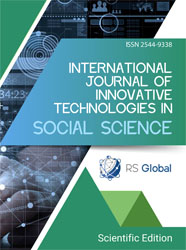CHARACTERIZATION OF ENVIRONMENTAL INEQUALITIES AMONG A MINING TOWN'S NEIGHBORHOODS CASE STUDY: OUENZA – EAST OF ALGERIA
Abstract
The waste resulting from mining can contaminate waterways or seep into soils and seriously pollute the environment; therefore it can impact the health of residents. However, these impacts are often deemed differently by this population. This difference is commonly called: "Environmental inequalities". This article spots the light on characterizing environmental inequalities in the mining town: Ouenza, which is located in the extreme east of Algeria. Through a questionnaire conducted in five areas of the town and using sphinx software to analyze results by CFA, we attempted to identify the impact of the extraction activity in this town and to determine the inequalities among the different zones and the factors behind them such as the proximity or the direction of wind.
References
Guillaume Faburel, “Espace population société, environmental inequalities as inequalities of means of inhabitants and territorial actors”,(2005), p 111-126. https://doi.org/10.4000/eps2430.
Lionel Charles an all, "The Multiple Facets of Ecological Inequalities", Sustainable Development and Territories, (2007).
Cyria Emelianoff Syllepse, Revue Ecologie et Politique Sciences & Techniques, Sciences de la vie, N° 29, (16 June 2004).
Lionel Charles and all, «The multiple facets of ecological inequalities», Sustainable development and territories Economics, geography, politics, law, sociology Vol. 11, n°2 (July 2020).
Laigle L. and Oehler V., “The social and environmental challenges of urban development: the question of ecological inequalities”, final report for the PUCA – MELT, (February 2004), 100 pages.
Jean Claud Rosso, https://jeanyvesthorrignac.fr/wa_files/info_20706_20ouenza.pdf accessed (June 25, 2019).
G. Saporta, "Probabilités, analyse des données et statistique", Editions Technip, Paris, 656 p., (2011).
T. Foucart. “Factor analysis of multiple tables”. Masson, Paris, (1984).
J. Ward Jr, «Hierarchical grouping to optimize an objective function., » Journal of the American statistical association, vol. 58, n° 1301, (1963), pp. 236 – 244.
DIGBY P.G.N. & R.A. KEMPTON, “Multivariate analysis of ecological communities”. Chapman and Hall, London, New York, (1987), 206 p.
GAUCH H.G., “Multivariate analysis in community ecology”. Cambridge Univ. Press., Cambridge, (1982), 298 p.
SHI G.R., “Multivariate data analysis in palaeoecology and paleobiogeography”- A review. Palaeogene, Paleoclimate, Palaeoecol.: (1993),199-234.
WARTENBERG D., S. FERSON & F.J. ROHLF, “Putting things in order: a critique of detrended correspondence analysis”. Am. Nat. 129, (1987), 434-448.
WILLIAM W.T. & G.N. LANCE, “Choice of strategy in the analysis of complex data. Statistician” 18: (1968), 31-43.
J. Thioulouse and D. Chessel. “I of the typology of state and the typology of functioning by triadic analysis”. Acta OEcologica, OEcologica Generalis, 8:463–480, (1987).
Views:
125
Downloads:
76
Copyright (c) 2024 Berrahail Guendouze, Soufiane Sid Ahmed, Brahim Djebnoune

This work is licensed under a Creative Commons Attribution 4.0 International License.
All articles are published in open-access and licensed under a Creative Commons Attribution 4.0 International License (CC BY 4.0). Hence, authors retain copyright to the content of the articles.
CC BY 4.0 License allows content to be copied, adapted, displayed, distributed, re-published or otherwise re-used for any purpose including for adaptation and commercial use provided the content is attributed.











